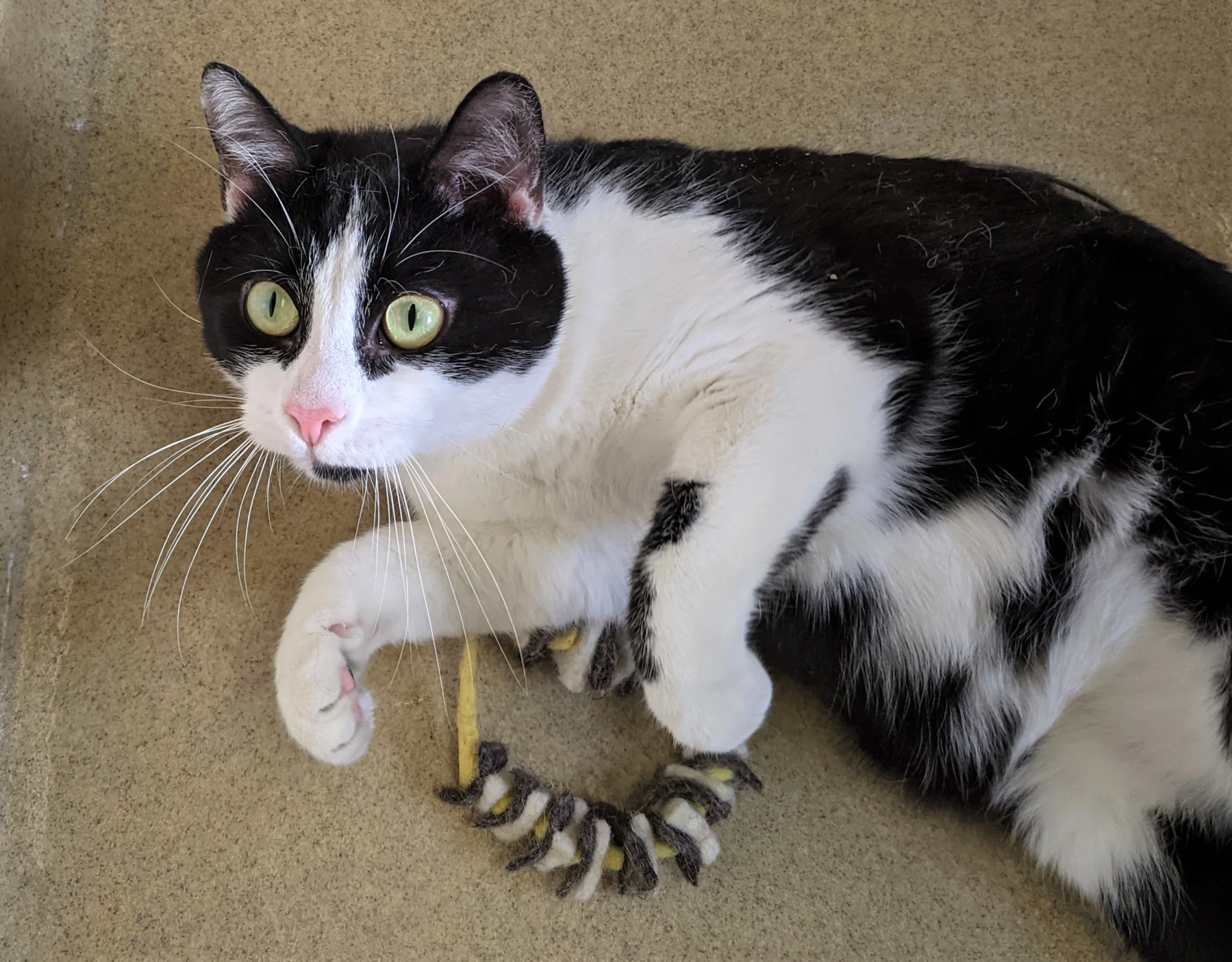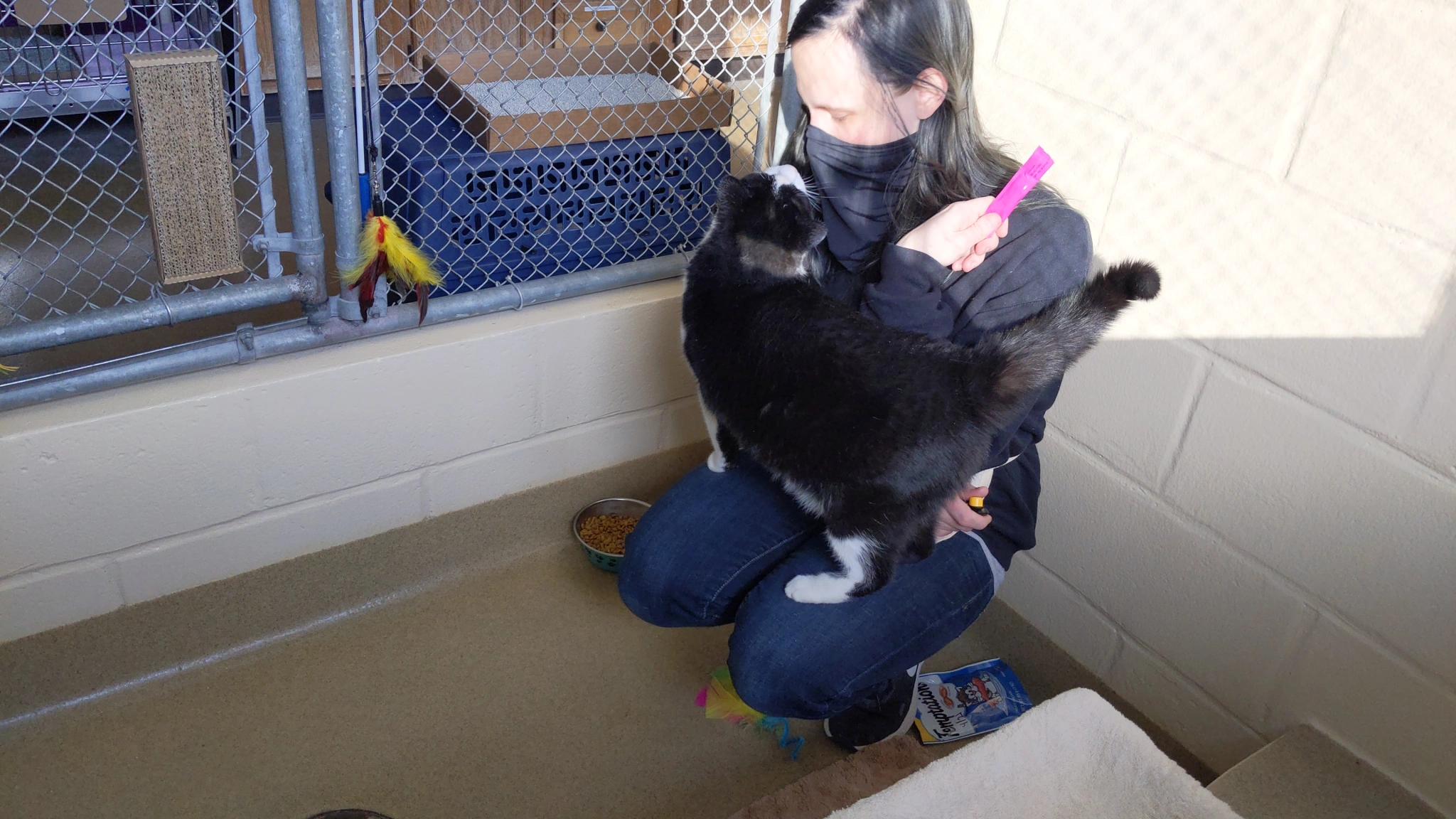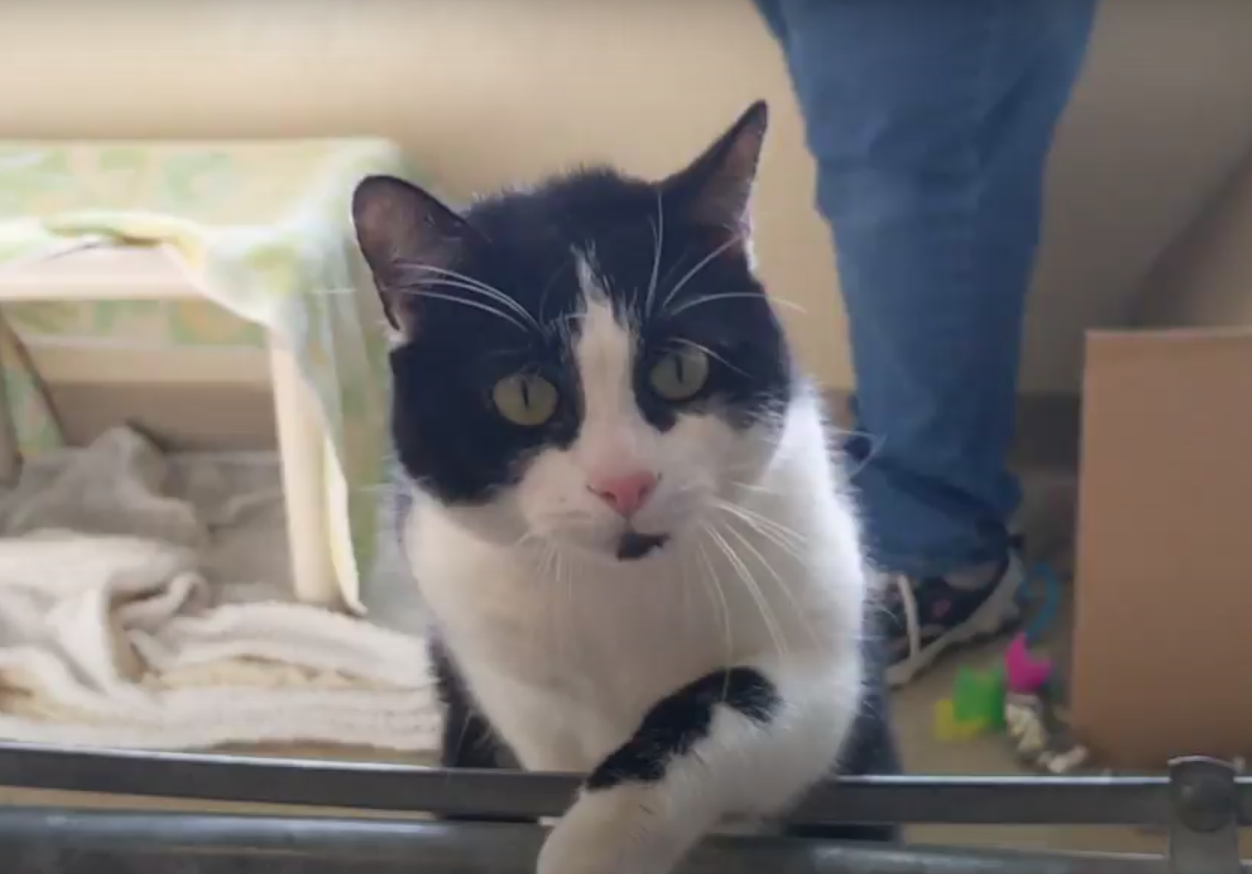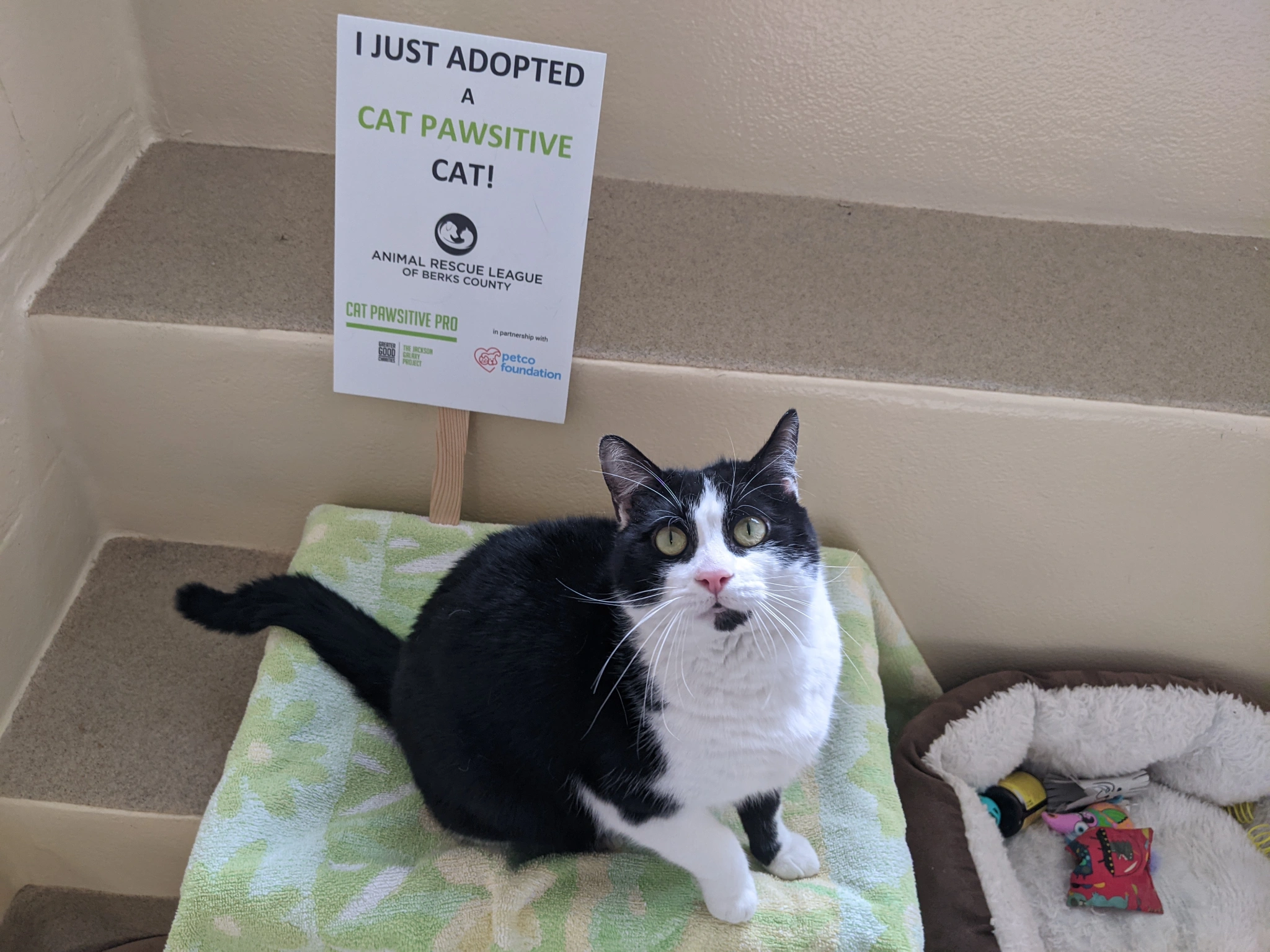
Relationships Ravaged: Redirected Aggression
RRedirected aggression…we’ve mentioned it a lot in this blog, but what exactly is it? I’ve seen it referred to in a lot of ways on the internet, some correct, some technically fitting in terms of semantics but not by categorization (I mean, semantically, your cat is redirecting onto you if they’re simply in pain and taking it out on you, but that’s not what redirected aggression is, that’s pain aggression. Redirected aggression is a very specific thing with very big consequences; stronger than that of other forms of aggression. Today we’re going to talk about what it is, how to avoid it, and some means of treating it.
So, wait…what is it then?
Redirected aggression is when a cat is frightened or agitated by a stimuli they cannot access or cannot properly process and associate or redirect to a different target – most typically a guardian or another animal in the home.

Alfalfa, a sweet boy whose guardian I was trying to assist with his redirected aggression in-home, but ultimately required surrender. We worked with him for a few months in shelter to assess likelihood of regression, sent him to a foster home, and eventually, he found his new home. ❤
The most common scenarios are cats seeing other cats outside of the home while looking out the window then redirecting onto another cat inside of the home sitting near them, or their guardian as they cannot attack the cat that triggered them. Another common case is one triggered by an unfamilliar sound either outside or inside of the home, like a loud truck, children screaming at a nearby playground, a human yelling in pain, or a fight between other animals in the home, etc. The cat then associates that startling sound with the next living thing they pass by in their panic - that they can actually interact with. (Or, whatever living thing was the last to pass them by) I once had a case where a cat began attacking its guardian after she began losing her balance and experiencing falls. The first time she fell and began crying the cat ran from the opposite end of the house and attacked her, from there, any time she’d cry or say “Ouch” she was a target. This can also happen with positive punishment. If you’re using things like spray bottles the cat associates the negative stimulus with you or someone else in the room rather than the spray bottle and may end up attacking. If continually exposed to a trigger without the time to decompress immediately following an event, this may become a learned association, turning it into generalized aggression towards that target. This is very hard to break and very dangerous.
What about that scent stuff you mentioned about taking cats to the vet and them attacking each other afterwards, is that it?
Nope! That is feline non-recognition aggression. There are a lot of different types of aggression, aren’t there?!

Alfalfa liked to get up close and personal in his training sessions...
What can we do about it?
The best thing to do for redirected aggression is to immediately sequester the cat for at least a 24-48 hour period. Get them in a room or crate, alone and try to make sure they have at least what’s necessary for feeding and littering in that time, providing additional care would be great but may not be possible with them in such an elevated state. Keeping everyone safe and limiting stress and stimulation are the most important factors here. It may take even longer than this for them to calm – go by their pace. If they need to be confined for longer it will be important to try your best to implement more enrichment however you can, and maybe discuss medication with your veterinarian.
From there you want to try and identify the trigger. What started this? This can be hard, especially if it was a fight between two cats in the home…but there may be signs. Was there bloodshed? Where is the blood? Might that have been where it started? Was it near a window? A TV? Anything that moves or may be loud? Did you hear a noise? What were you doing? (Perhaps you were putting dishes away in the kitchen and the clank of a pan was enough to startle! – You might not think of it because you put dishes away regularly, but it could have been a trigger!) Once you identify a trigger you want to limit their exposure to it in the future.
They may also be very sensitive to the target of their aggression from here on out and vice versa. This kind of event, very understandably, can have a highly detrimental effect on relationships. It's caused children to be terrified of their former companions...and when it comes to other animals, they may require very slow reintroductions even after the first event. If it happens repeatedly, the relationships may become irreparable.
Calming aids and behavioral medication can always be helpful. Feliway multi-cat (or optima as it appears multi-cat and classic may be getting pulled off the market for that), hemp oil, or a prescription medication may be the key to finding harmony again. Personally, due to the severity of this aggression I often recommend at least a short regimen of gabapentin, but don’t be ashamed for seeking out something more long-term like fluoxetine. It doesn’t have to be forever and it may help exponentially to bring those stress levels down and allow them to react rationally again.
As always, energy management is important. Play therapy and problem solving exercises like food/treat puzzles and clicker training will help with just about any behavioral problem.
If it happened near a window, you may have to purchase vinyl covers to obscure their view out and prevent their exposure to another trigger or find some other way to obscure their view out. You can also use humane deterrents such as ultrasonic options or motion activated water sprayers to keep cats and other animals off of your property if that was the cause.
The reintroduction process may be complicated. It may follow the same process typically used for bringing a new cat home…simple things like feeding on opposite sides of the door, baby gates, short supervised exercises, and things may go splendidly. (Or for humans, just coming in and sitting quietly – reading, offering treats – with whatever level of protection needed at any given time, maybe awaiting calm and rewarding) If the cat(s) cannot be calm around each other, you may have to limit sessions to only a few seconds, reward, end, and try to extend over time in hopes that might work. If unable to do so, either because it is unsuccessful or because it is too intensive, then it may be best to consider rehoming one of the cats. It’s a heartbreaking decision to make, but unfortunately once no longer around the trigger, the problem with aggression is typically gone. These cats often come into the shelter and never have an issue again.

Are there any studies about this?
Yes! Let’s go over one. In one study of 19 cats with a history of redirected aggression and 64 without, there were 22 incidents among those 19. The majority of the incidents were caused by loud noises such as falling objects, televisions, drills, and cell phones, at a staggering 11, followed by other cats at 10. In half of these cases, it was caused by the other cat in the home rather than seeing one outside of the home – following a loud vocalization from another cat, or during a fight between cats. The remaining incident was caused by a visitor to the home. These cats most commonly redirected towards their guardians, making up 14 of these 22 cases. The second most common redirection is towards other cats in the home, at 7 incidents. 2 events were towards unfamiliar people, and one event was towards a dog in the home. Compared to cats without histories of redirected aggression, they were far more likely to have fear of noises, less likely to spend time outdoors, more likely to be from smaller households (two or less people). The aggression was determined to have been sparked by fear due to most cats having been noted to be in defensive positions just before attacking. The study concluded that it is important for guardians to habituate kittens to novel items, experiences, and sounds early on to prevent such events in the future and lessen the fear response.
Redirected aggression doesn’t discriminate, all cats experience it. In this study, 17 of the cats who experienced it were domestic short hairs, 1 was a Persian, and another a Siamese. I might say it’s likely the numbers are so high simply due to domestic short hairs being the most…common cat. Our beloved mixed breed! 11 were male, 10 of which were neutered, one intact. 8 female, 5 spayed and 3 intact. Mean age was 3.6 years, they ranged from 1-11. They were obtained from all different sources, the majority were strays, next highest rehomed, bought from pet stores, with two remaining with unknown origin. All guardians obtained their cats under 2 years old – between 1 week and 18 months. 17 were indoor cats, and 11 of those were in multi-cat homes. Guardians of 12 of these cats were followed up with, and 8 of them continued to have redirected aggression events – two of them had been euthanized due to the aggression. Four never experienced an event again.
Although not a study, I’ve seen it reported that the more cats you have, the less likely it is for redirected aggression to occur. This does make a bit of sense. Consequently, the more people around, the less likely it is to occur. Cats that experience RA are used to calm and quiet environments and likely haven’t experienced a whole lot of hustle and bustle, much novel stimuli, and aren’t used to much noise. Cats from busier households aren’t too easily startled because there’s a lot more going on. I’m not saying to start hoarding cats or move all of your friends in, but it is very helpful to get them used to being exposed to novel stimuli. Ansd I mean, if you were looking for an excuse to get another cat…it might keep you safe!
Redirected aggression is one of the most serious forms, so it’s very important we address it and do everything we can to avoid it. Horrible injuries can result, it can break up homes, cause serious heartbreak, and as seen above...even cost lives. We’re still working to fully understand it – is there something intrinsically different about the cats who experience it beyond a fear of noises? Is there something genetic? Something behavioral, environmental? Maybe we’ll find a key one day. But for now, this is what we know. I’ll continue to learn up on this one, as it’s always a tricky one to counsel on. I never feel confident with redirected aggression, maybe because of the severe consequences.

It was such a happy day!
I think the biggest takeaway here is that it doesn’t have to be a death sentence for a cat. So often when called for these issues, euthanasia is the first fear or even recommendation – whether it be from other professionals or from the guardians themselves. This is a very special type of aggression that imprints on a target, without that target there is often nothing to worry about. With the knowledge that it's happened before and treatment advice for if ever it occurs again, these cats can be rehomed without issue and the guardians can be set up with the tools to deal with reoccurance before it imprints as generalized aggression. I have not successfully treated it in-home many times – as often I’m called long after the first event, but I have successfully seen these cats to new homes and seen them thrive…and I think that’s a pretty big deal.
Until next time.
-Meg
